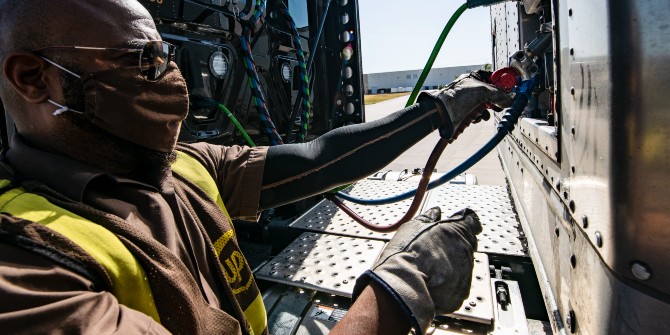With internet use at a record high, Jean-Christophe Plantin (LSE) discusses how much we actually know about the communication infrastructure on which many of us rely heavily in our daily lives.
The COVID-19 pandemic and related stay-at-home orders have generated a dramatic increase in broadband consumption. As reported by the BBC on the penultimate day of 2020, internet use in the UK doubled that year, with Openreach’s total customer base using 50,000 petabytes of data as opposed to 22,000 in 2019. More than a year into the pandemic, has this intensifying reliance on communication networks increased the public understanding of the internet infrastructure? Are we now more “literate” on broadband matters than we were a year ago?
In my work, I study the various actors that are involved in building and maintaining our digital infrastructure—such as network engineers working for large tech giants, activists producing radiation data after a major nuclear crisis, and data processors cleaning datasets at an archive. A statement I encounter very often in my field (the social study of infrastructure) is that infrastructure breakdown can be seen as an outage, but also as a productive moment to generate knowledge. As Susan Leigh Star put it in her notes on how to study infrastructures ethnographically, they become more visible when they break. At home, we become aware of our electrical or plumbing systems when something goes awfully wrong, and we have to call an engineer who opens up the cupboard and fuse boxes that we usually do not venture into. While this statement is often criticised, especially in anthropology, for being true mostly in the Global North—whereas in some Global South countries, infrastructure breakdown is the everyday normal and not the exceptional—it can still be a productive approach.
Applied to our current situation, we can similarly see the pandemic and related stay-at-home orders as a moment of severe disruption of our everyday life, but also one that brings light to the communication infrastructure we depend on every day. I would like to highlight three properties of our broadband provision that have gained mainstream attention due to the pandemic:
- First, our broadband is not infinite. In early March 2020, internet service providers and regulatory bodies (e.g. the European Union Commissioner) asked the providers of popular streaming services—such as Netflix, Amazon Prime, or YouTube—to reduce the quality of their videos in order to lower their overall bandwidth consumption and to allow other services to run.
- Second, the way we organise our home and how we use our devices matter. Who knew that using a microwave could reduce the quality of our signal at home? Ofcom published a checklist as part of its Stay Connected initiative in March 2020 to give advice to increase signal reception, ranging from the appropriate location for our home routers, making calls at less common times (instead of on the hour or half hour), or using an Ethernet cable instead of WIFI only.
- Third, our internet depends on technicians, support workers and engineers who are usually invisible but who constantly work to make sure the network is up and running. Data centre workers, who maintain the servers that store our data and content, were classified as key workers by the UK and the US state of California as early as March 2020. Also, the increasing need for support for broadband users revealed the international division of labour, as well as the dependence of UK-based service providers outsourcing their support teams to India and the Philippines. When these two countries started implementing lockdowns in 2020, these overseas support teams became less available, leading Virgin to hire staff in the UK.

So where do we go from here? How can we turn the knowledge we gained during the pandemic into something more sustainable and systematic? In 2018 Jonathan Gray, Carolin Gerlitz and Liliana Bounegru proposed the term data infrastructure literacy to think about the skills needed in our digital society—beyond simply working with datasets, but also to get a deeper understanding of the “wider socio-technical infrastructures through which data is created, stored and analysed.” I would complement this goal by adding a more literal understanding of the term infrastructure:
- First, by transmitting knowledge on the very basics of networking: what is a router, what and where is a service provider, what is a data centre and what is its function? There are already fantastic popular books on this topic, such as Tubes: Behind the Scenes at the Internet from Andrew Blum, or Networks of New York: an Illustrated Field Guide to Urban Internet Infrastructure from Ingrid Burrington.
- Second, going beyond the technology only, we could ask: what are the invisible forms of labour that we depend on to run our internet? Who are the technicians, the engineers, the call centre staff? Where are they in the world, under what status do they work, and what would we learn by making them visible?
Gaining knowledge, or at least awareness, of these aspects of a network could hopefully provide us a more robust understanding of how our current internet infrastructure work, but also lead us to have a better engagement with debates on future infrastructure. The conspiracy theories spreading online and linking 5G with COVID-19 led to the actual vandalism of cell towers and attacks of many engineers across Europe—ironically enough, these attacks targeted equipment that had nothing to do with 5G. As my colleague Robin Mansell and I showed in a recent report, the UK press coverage of 5G emphasises the groundbreaking applications that 5G will support, but does not ask the hard questions in terms of users’ privacy or the extension of personal data collection. Providing more knowledge on current and future broadband and mobile networks could be a step toward bringing to the fore the real debates about 5G, beyond fallacies and conspiracies.
This post is based on a talk given at the CO:RE Theories Webinar: Children and the Digital Environment, 7 May 2021, and first appeared at the Media LSE blog. It represents the views of the author and not those of the COVID-19 blog, nor LSE.





